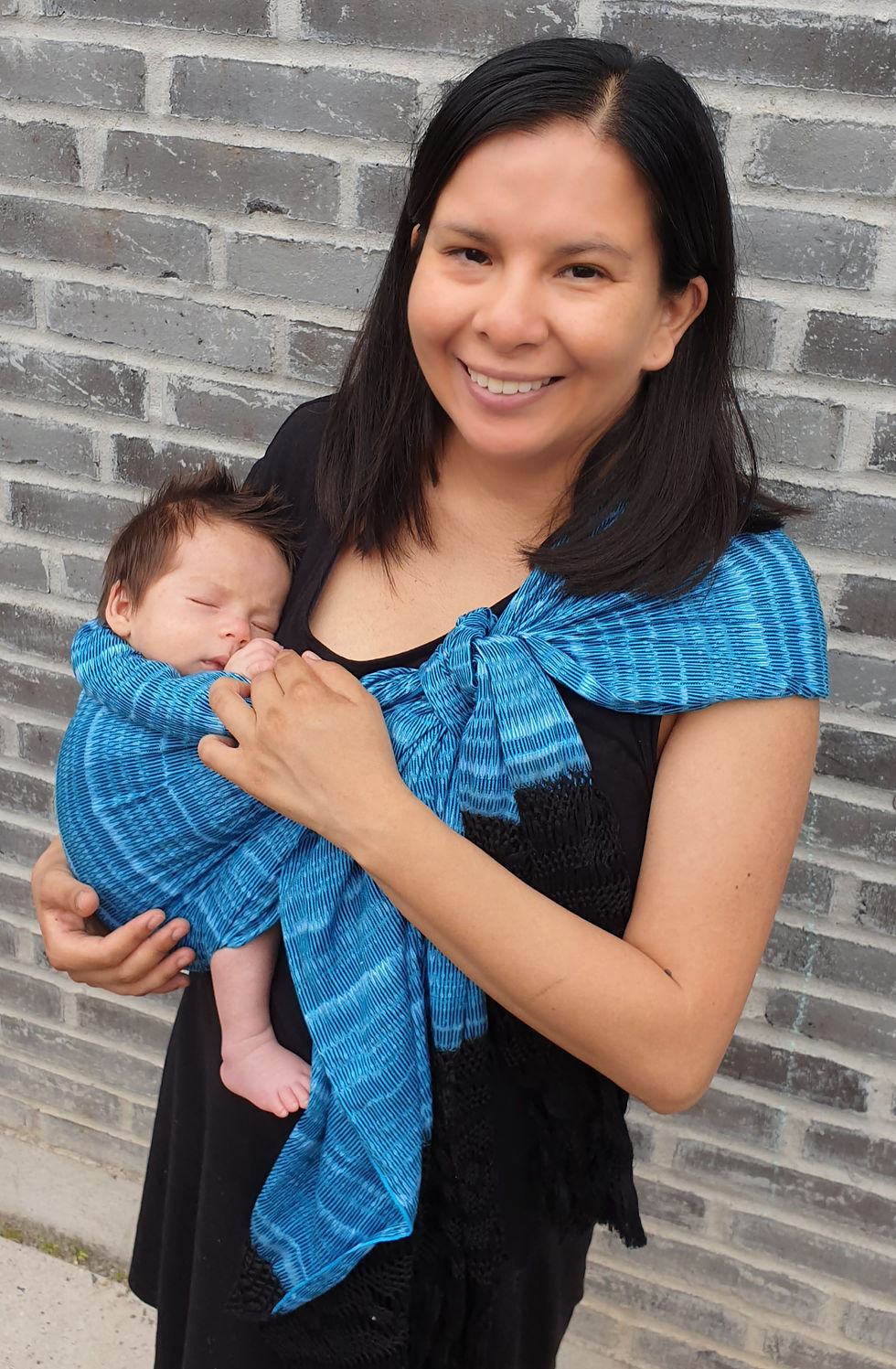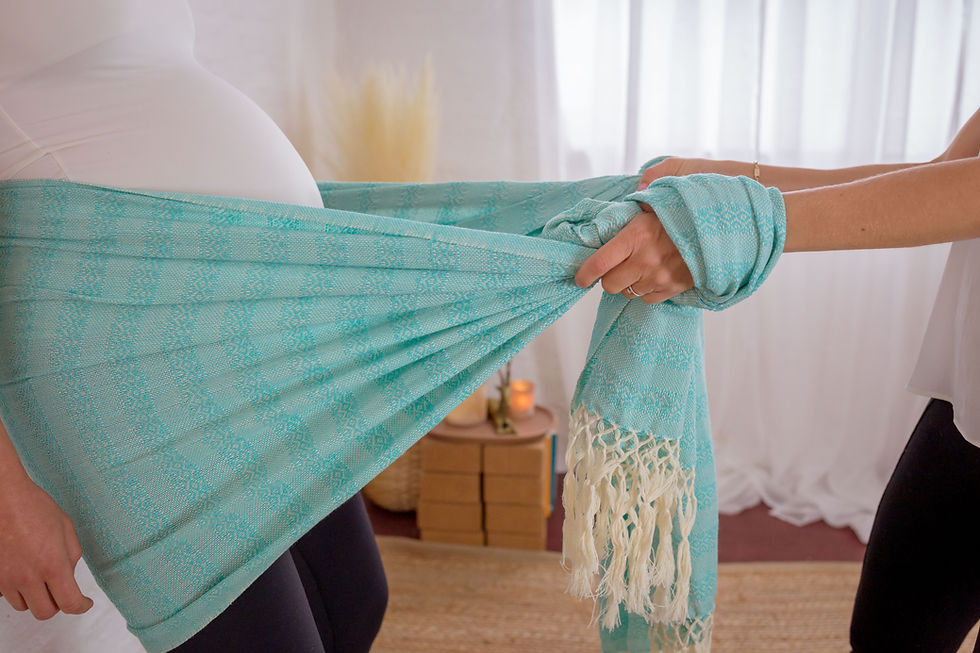Authentic Rebozo Massage: Tradition, Connection, and Respect in Birth and Beyond
- Aug 27
- 5 min read
The rebozo is much more than a piece of cloth. In Mexico, it is a national symbol, a family tradition, and an expression of identity. Woven by artisans for generations, it has been part of our everyday lives and our most important rituals.
Today, more and more people hear about ‘rebozo massage’ in the world of birth, as its reach has expanded around the world. But authentic rebozo massage is not only a technique — it is history, culture, and connection carried in threads.
What is a Rebozo?
A rebozo is a long, rectangular woven cloth. To someone unfamiliar, it might look like a scarf or a shawl — but it is something unique. It is a rebozo, with its own meaning and place in Mexican identity.
It accompanies us in so many ways. Mothers wrap their babies in it and hold them close. Women use it for warmth, for comfort, or simply to feel contained and hugged. Families pass them down through generations, and artisans continue to weave them, each design reflecting the community where it was created.
This is why the rebozo has a place in birth. It offers mothers support and containment without intrusion — a way of holding, of giving presence, without the need for words or touch.
Wrapped in memories
For me, the rebozo is the hug of my family.

I was carried in rebozos by my grandmother and aunts, just as my parents had been carried by theirs and generations of Mexican children. Later in life, I chose to wear a rebozo on my wedding day and at my graduation — symbols of continuity, love, and belonging.
When I became a mother myself, I carried my babies in rebozos too. Even now, when their feelings grow big, I wrap them close to give them safety and containment. And still today, when life feels heavy or I return from a deep session with a client, I reach for my rebozo. Wrapping myself in it brings me back to myself.
It feels like home.
My Journey as a Doula
When I moved to Denmark, I didn’t know much about the rebozo’s role in childbirth. I wore it, I loved it, I valued it as part of my Mexican identity — but I was not familiar with the ways it is used by traditional midwives to support women in labor.
That changed when I became a doula. I felt a deep need to reconnect with this tradition, not only as part of my personal life but as part of my professional path. I returned to Mexico and sought out the wisdom of traditional midwives. I studied with Guadalupe Trueba, a respected midwife and author, and spoke with the women of my family about their own experiences and traditions around birth and the rebozo.
Those conversations, teachings, and practices changed everything. Over the years, I have continued to learn, to adapt, and to use the rebozo in ways that feel right for each mother. Sometimes it fits perfectly; sometimes a mother is not open to it, and that is always respected. For me, rebozo care is never about applying a technique — it is about listening, honouring, and offering support with authenticity.

More Than just a "Rebozo Massage"
It is common to hear about the rebozo only as a form of ‘rebozo massage.’ But for me, it is never just that.
The rebozo is a way of getting close without crossing boundaries. It is a way of holding emotions, of creating safety, of saying “you are not alone.” It can help release tension, yes — but its real power is in the care and the connection it creates.
Cultural Meaning and Respect
The rebozo is part of who we are as Mexicans. It is cultural identity, family history, and living art. Each rebozo carries the voice of its artisan, the memory of its community, and the knowledge of generations.
Some rebozos are woven for daily use; others are made with fine threads for weddings, celebrations, or sacred rituals. Some are even considered art pieces, so detailed that they are displayed rather than worn. And in certain regions, rebozos accompany people at the end of life, woven into funeral traditions.
This is why the rebozo must be respected. It is not just fabric, not just something you can imitate with a bedsheet or a simple scarf. It comes with the legacy of Mexican midwives who have used it for centuries and with the artistry of weavers whose knowledge is now at risk of being lost. To use it today is to stand in that lineage — and with that comes responsibility.
The Rebozo in Care
When I introduce the rebozo to parents, I always remind them that it is not about learning ten perfect positions. It is about presence.
Sometimes a mother needs to be held because she feels she cannot continue. Sometimes she needs space to open, or containment when everything feels overwhelming. Sometimes she just needs a hug that does not overwhelm her with touch.
The rebozo can offer all of this.
In pregnancy, it relaxes and brings comfort.
In birth, it supports and grounds.
In the postpartum, it helps to close and restore after the immense opening of labour.
It is never about “doing it right.” It is about asking, “What does the mother need right now?” and using the rebozo as a way to meet that need with care.

Honouring the Rebozo Today
If you are drawn to the rebozo, I invite you to honour it in the way it deserves.
Learn from traditional Mexican midwives and teachers. Choose authentic artisan-made rebozos, not mass-produced copies. Understand the history, the weaving, the culture behind the cloth you hold.
This tradition is fragile. Many artisans are aging, and younger generations often cannot continue weaving because there is less respect and demand for handmade work. By supporting artisans and respecting the origins of the rebozo, you help keep it alive.
An Invitation to Experience Authentic Rebozo Care
Rebozo care is not just about releasing tension. It is about connection, support, and family.
When I offer rebozo care, I also invite partners to join. I show them how to hold the mother with it, how to offer presence and comfort. This strengthens the bond between them, creating a circle of care. And when the baby arrives, the rebozo becomes part of that circle too — wrapping them close to the heart, continuing the tradition of love and closeness.
If you would like to experience authentic rebozo care — rooted in Mexican tradition, respectful, and deeply supportive — I invite you to connect with me. Together, we can explore how this beautiful practice can hold and support you and your family.
If you are in Copenhagen and would like to experience authentic rebozo care, I would be honored to support you.
I offer rebozo sessions during pregnancy, birth preparation, and postpartum — always rooted in Mexican tradition and adapted with respect to your unique needs.
💌 You can contact me here to book a session or learn more.
Let the rebozo hold you with the same warmth and strength it has carried for generations.
For learning more about the history of Rebozo and my thoughts about cultural appropriation Check out this post.
.png)



Comments